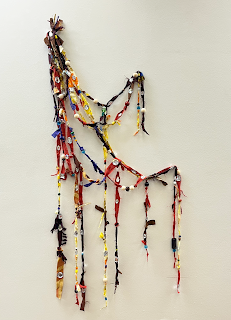Figurative Bust Sculpture
The topic I selected for this piece is human and sex trafficking. Through sculpture, I wanted to convey the idea that women are typically targeted for trafficking and often times are not able to escape the trafficking system. The figure pictured on the left, the female figure, is presented with a rope acting as a ponytail, wrapping around the neck and being attached to the stake that impales her. This represents the idea that women are often times targeted because of their ponytails--they provide an easy way to grab a woman and kidnap her. This leads to the victim being tied into the trafficking system and not being able to escape. The female figure will ultimately die through the system--she bleeds pink, representing all the women who have been subjected to this. The male figure, the trafficker, is presented above the female, symbolizing how he has power and control over those who are caught up in the system. He is pictured with a hat on to conceal his identity, and holding the rope that keeps the female figure from escaping.
Research:
1. The FBI states their efforts to help with the human trafficking issue. Along with their statements, they quickly explain different types of trafficking. They write, "Under the human trafficking program, the FBI investigates:
- Sex trafficking: When individuals are compelled by force, fraud, or coercion to engage in commercial sex acts. Sex trafficking of a minor occurs when the victim is under the age of 18. For cases involving minors, it is not necessary to prove force, fraud, or coercion.
- Labor trafficking: When individuals are compelled by force, threats, or fraud to perform labor or service.
- Domestic servitude: When individuals within a household appear to be nannies, housekeepers, or other types of domestic workers, but they are being controlled and exploited."
2. In 2019, there was a total of 22,326 human and sex trafficking victims reported, 4,384 traffickers, and 1,912 businesses suspected of contributing to trafficking. Trafficking tactics include--but are not limited to--intimate partner/marriage proposition; familial; job offer/advertisement; posing as a benefactor; false promises/fraud; smuggling. The picture below shows the increase in trafficking from 2015-2019.
In-process pictures:














Comments
Post a Comment